How to Create an Employee Schedule in Google Calendar
Learn how to make an employee schedule in Google Calendar in 5 simple steps (2 are optional!), and discover a better method for scheduling.

In this post, we’re going to walk you through a five-step process for how to make an employee schedule in Google Calendar. We’ll also highlight some of the benefits and disadvantages of using Google Calendar for employee scheduling and show you a solution that will significantly reduce the amount of time it takes you to create work schedules.
Buddy Punch makes employee scheduling easier than ever. Build schedules quickly with our drag-and-drop builder, create recurring shifts for employees who work the same schedule each week, assign employees to work at specific locations, see employee availability while you’re building schedules, send employees notifications when a new schedule is published, allow employees to trade shifts, and much more.
The benefits of using Google Calendar for employee scheduling
Creating employee schedules in Google Calendar has three big benefits:
- Making a work schedule in Google Calendar is easier and faster than making one with pen and paper. You can easily undo mistakes, set up recurrences for repeating shifts, and see scheduled time off in the same place where you’re creating your schedule.
- Using Google Calendar to create employee schedules is free if you are already paying for Google Workspace. If you are already paying for it for email, there’s no additional cost to use it for scheduling.
- Google Calendar can be shared with all employees, so you don’t have to field calls from employees asking about their schedules. They don’t need to come to work or call you to find out when they’re scheduled for future weeks, and everyone on your team can see who’s working at any time.
The disadvantages of using Google Calendar for employee scheduling
Creating employee schedules in Google calendar also has a number of disadvantages:
- What you save on costs you’ll lose in time. Creating employee schedules in Google Calendar is extremely time-consuming. You have to create meetings for all employees, remember to invite them, and make sure you have your settings correct so the schedule can’t be updated by other team members.
- You may make scheduling mistakes. It can be difficult to keep track of every employee’s availability, preferences, and scheduled time off when creating schedules in Google Calendar. You may have to create and reference multiple documents to keep track of everything you need.
- Work schedules in Google Calendar can be hard to read. If you’re scheduling a lot of employees, you’ll end up with stacks upon stacks of entries that can make it difficult for you to see who’s working and make sure you have ample coverage for each shift.
- Google Calendar doesn’t offer helpful scheduling features. You won’t be able to let employees request shift trades with one another, and it’s not easy to schedule employees to work in different roles or at different locations.
For some teams, these issues are not a deal-breaker. For other teams, it’s much more efficient to use dedicated employee scheduling software. If that sounds like you, you can try Buddy Punch’s employee scheduling software for free for 14 days.
How to create an employee schedule in Google Calendar in 5 steps
Follow these step-by-step instructions to make a schedule for employees in Google Calendar.
Step 1. Create a new calendar
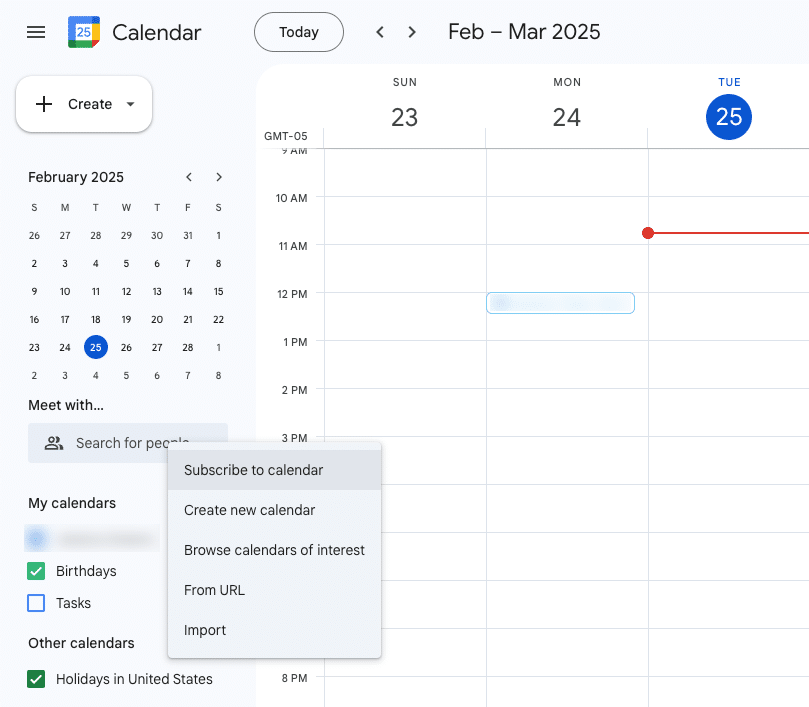
In the left sidebar, click the plus icon next to “Other calendars” and select “Create new calendar.” Give your calendar a name like “Work Schedule,” then click “Create calendar.” Once your calendar is created, you’ll be able to see and navigate to it in the left sidebar under “My calendars.”
Step 2. Add all team members to your calendar
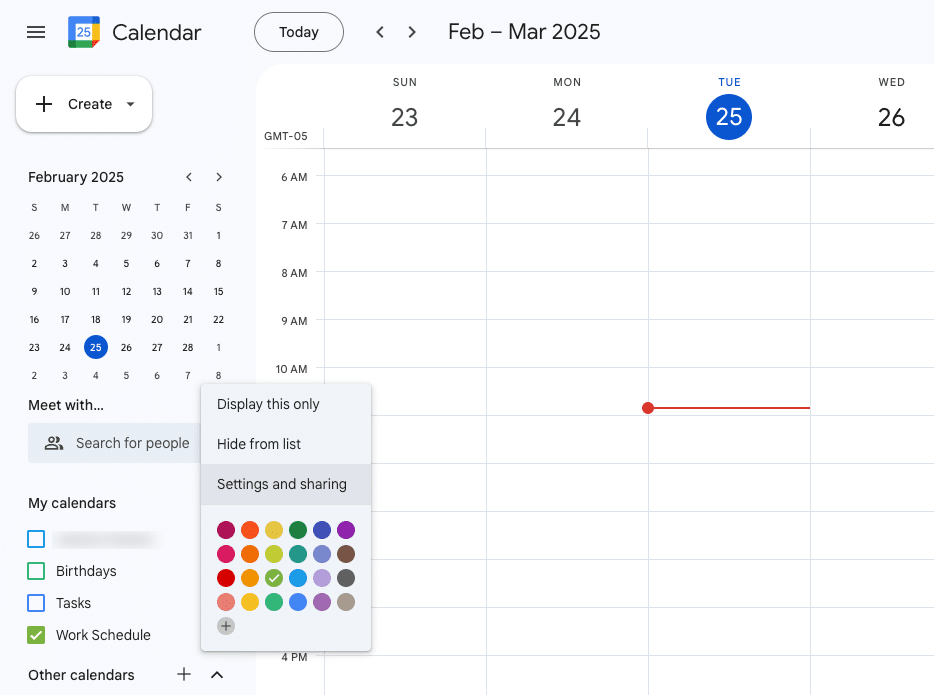
First, uncheck any other calendars so you’ll only see your work schedule calendar. Then, click the three vertical dots next to your work schedule calendar, and select “Settings and sharing.”
Scroll down to the section called “Shared with,” and click “Add people and groups.” This allows you to give all of your employees access to your calendar. If you already have a group for all employees, you can select that group to add everyone at once. If not, you’ll need to add all employees individually.
Next, you’ll want to set the permissions for the calendar. If you don’t want employees to be able to make changes, leave the permissions set to “See all event details.”
Step 3. Add any upcoming time off to your calendar (optional)
While this isn’t a required step, it’s very helpful to be able to see when employees are scheduled to be off of work while you’re creating your schedule so you don’t accidentally schedule someone for a shift when they’re supposed to be off.
I like to do this by adding events to the top of the calendar listing who’s off. Then, when I’m creating schedules, I can simply scroll up to see who not to schedule for that day.
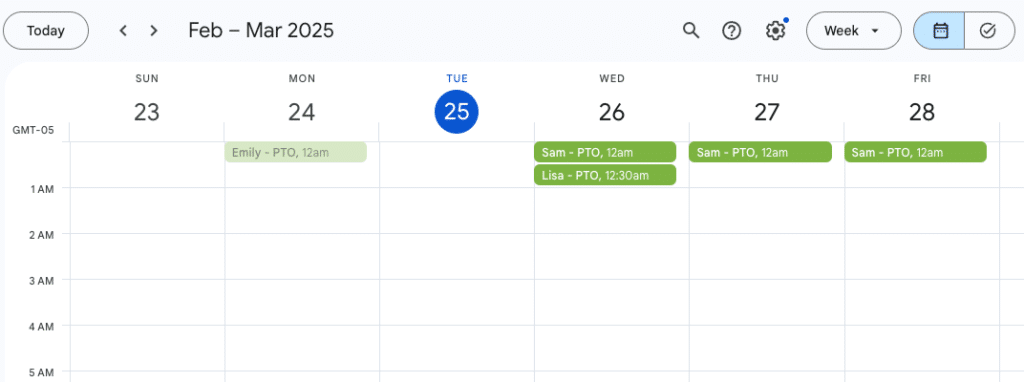
Pro tip:
Another way to avoid scheduling employees when they’re off is to have employees create an out of office event on their personal calendars that is set to “automatically decline existing and new meetings.” If this is set up, you’ll get an email if you schedule an employee while they’re off, which can help you make corrections quickly.
Step 4. Create new meetings for all employees’ shifts
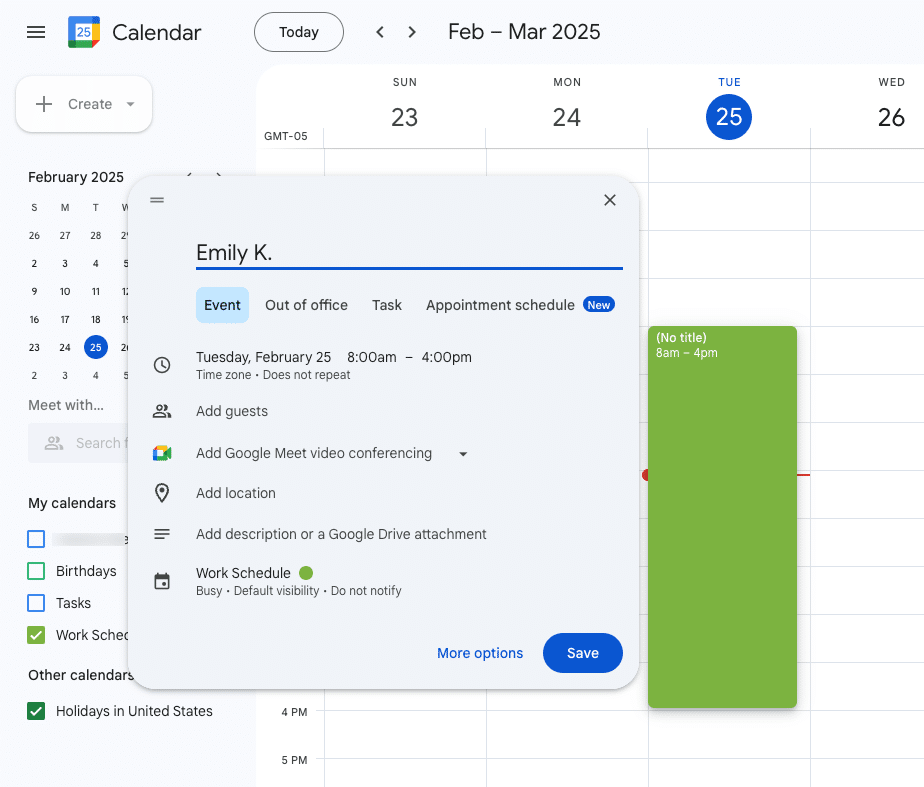
To create your schedule, simply click and drag your mouse to select the length of the shift you want to schedule an employee for. Enter their name in the “Title” field and add the employee as a guest. This will let you see when that employee is scheduled on your calendar and also add the meeting to their personal calendar so they can easily see when they’re scheduled to work.
Repeat this exercise for all employees until your schedule is complete.
Pro tips
- If you have multiple employees who all work the same shift, you can create one meeting for the shift and simply add all employees to it as guests.
- If you have employees who work in different locations, you can add a location to the event when you’re creating it. While Google Calendar won’t show you a visual indication of the locations in the overall calendar view, employees will be able to see where they’re working in the invite.
- If you have employees who work in different roles on different days, you can add the role they’ll be filling to the event’s title (i.e., “Emily K – Hostess”).
Step 5. Set events to recurring for repeating shifts (optional)
If you have employees who work the same shifts every week, you can set up an event to repeat. To do this, click on any event, then click the pencil icon to edit it. A screen will open that gives you more options.
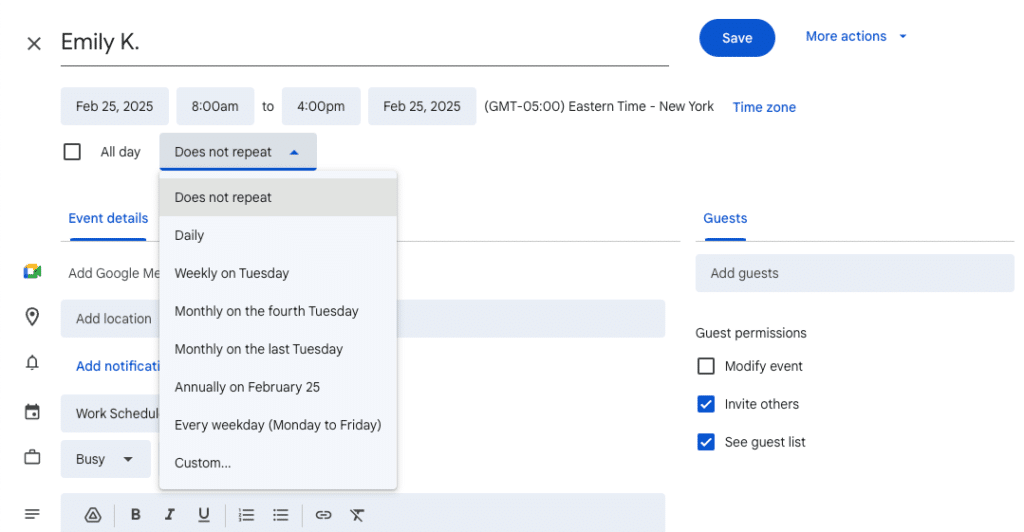
From here, click the dropdown that says “Does not repeat” and select how often you want the event to repeat. Select “Every weekday” if you want to schedule them for those hours Monday through Friday. Select “Weekly on [day]” if you want to schedule them to work those hours on that day for all future weeks.
You can also select “Custom” for even more options: schedule them to work that shift on that day every other week, set the number of weeks that the recurrence will continue, schedule them for that shift on specific days, and more.
With that done, you’re finished with the schedule for this week and also have a good jumpstart on schedules for future weeks! You and your employees will all be able to see exactly who is working and when, and employees will even be able to see their individual schedules on their personal Google Calendar.
Simplify your employee scheduling with Buddy Punch
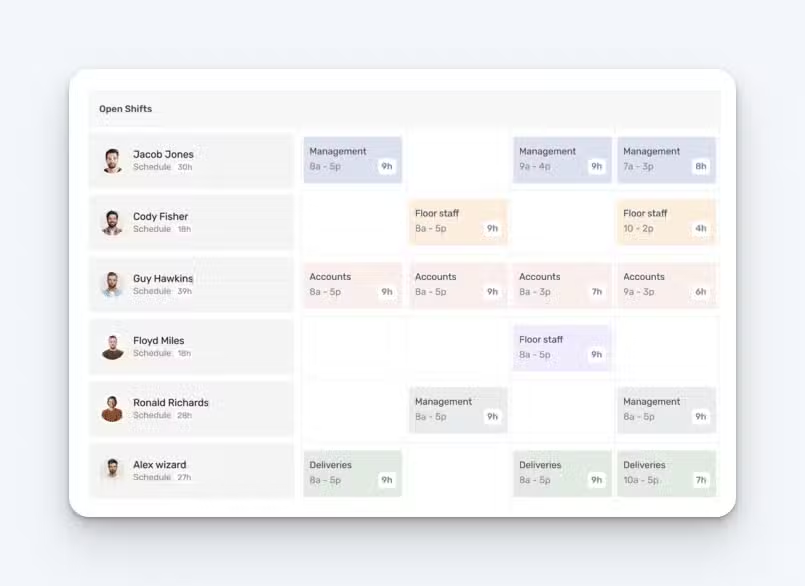
Buddy Punch is an employee scheduling app that’s user-friendly, has high customer satisfaction ratings, and comes with all of the features you need to create schedules quickly.
Buddy Punch’s scheduling tool displays all of your employees in one column and the days you’re creating a schedule for in subsequent columns. To create a shift, simply click in an open area, specify the shift’s start and end times, and add any employees you want to work that shift.
Repeat this for all of the days your schedule covers, then publish your schedule. Your employees will receive notifications that the schedule is live, and they can view their schedule at any time in the Buddy Punch app, which is available on the web and has mobile apps for both iOS and Android devices.
If your scheduling is simple, that’s all you’ll ever need to do. However, Buddy Punch’s scheduling tool also has all of the advanced features you need to create more complex work schedules.
Locations
Buddy Punch’s locations feature lets you assign locations to shifts so employees know not only when they’re working but also where. Your schedule can also be filtered by location so you can build schedules for each location quickly and easily, and different locations can be assigned different colors so you can quickly see where everyone will be working at a glance.
Departments
If you have employees working in different roles — such as server and host — you can create those different roles as departments in Buddy Punch. After that, you can assign the appropriate department to shifts so employees know when they’re working, where they’re working, and what position they’re filling.
Repeating shifts
If your employees work the same hours every day, every week, you can create repeating shifts to automatically add shift templates to future weeks. The future shifts won’t be published until you push the publish button for the schedule they apply to, but it gives you a big head start on creating future schedules.
If you do need to shift something around on a future schedule, that’s easy too. Buddy Punch’s drag-and-drop functionality makes it easy to move shifts to different days and times.
Employee availability
Nothing is more frustrating than working hard on your schedule, publishing it, finding out that an employee isn’t available to work on a day you scheduled them for, and having to start over.
With Buddy Punch, you’ll never run into this issue again. Employees can specify their availability in the app, and times when employees aren’t available show up on your calendar view. Plus, if you try to schedule an employee when they’re unavailable, the system will give you an error message and prevent publishing the schedule.
Shift trades and covers
When an employee can’t make their scheduled shift, either the employee or an admin/manager can open that shift up to be covered. You can select who should receive the cover request, and if another employee accepts it, the schedule adjusts automatically.
Additionally, when employees work out amongst themselves that they want to trade shifts, they can make that request in Buddy Punch. The request then goes to a manager or admin to be approved before the schedule adjusts.
Scheduling and much more
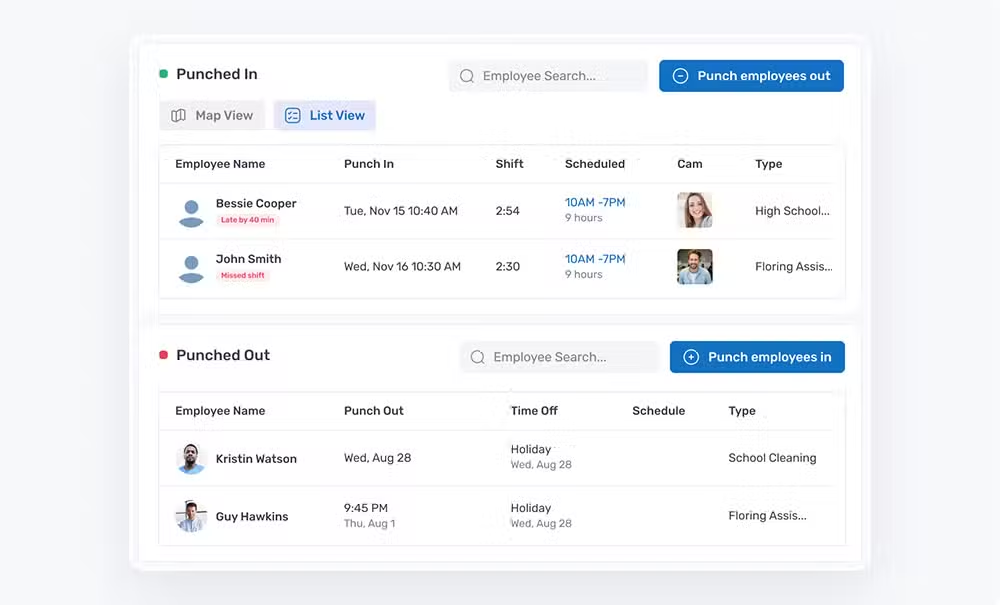
While Buddy Punch makes creating work schedules easier than ever, that’s not all it can do. It’s also a time clock that compiles time cards for you automatically, makes running payroll easier, and keeps your employees accountable with features like:
- Clock in/out reminders: If your employees haven’t clocked in or out within a certain amount of time after their shift starts or ends, Buddy Punch will automatically send them a reminder to clock in/out.
- Limit early/late punches: You can prevent employees from clocking in before their shift starts or automatically clock them out at the end of their shifts to prevent unplanned overtime and unexpected labor costs.
- Geofencing: Prevent employees from clocking in or out when they’re not on-site by creating geofences. If employees try to punch when offsite, the system will block the action.
- Photos on punch: If you’re concerned about buddy punching — where employees clock in and out for each other — you can require employees to take a selfie when they clock in and out. Those photos can be reviewed on their timecards.
- Payroll integrations: Buddy Punch integrates with popular payroll providers like QuickBooks, ADP, Workday, Gusto, and more, letting you transfer your time data to payroll in seconds and run payroll more quickly than ever before.
There are lots of additional features available in Buddy Punch beyond what we’ve covered here, and you can use them all or just the ones you need. View a complete list of Buddy Punch’s features.
Want to learn more about Buddy Punch? Start a free trial — no credit card required — watch a video demo, take an interactive tour of the product, or request a personalized demo.


